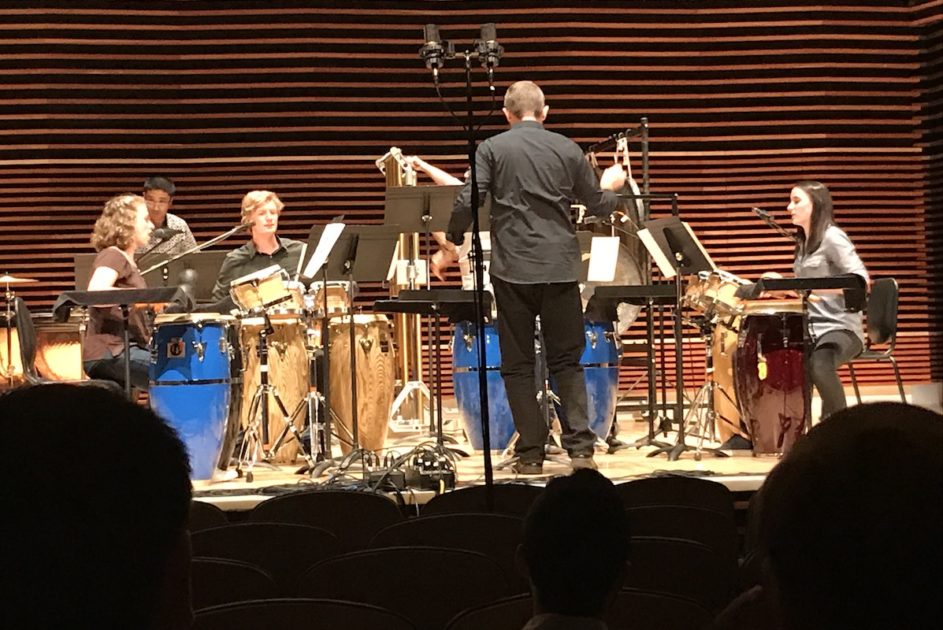New music, especially in the classical music genre, takes time to settle into the mainstream. The new music of 20-30 years ago can now be regularly heard in everything from movie soundtracks to TV commercials.
At UT School of Music this week, the Nief-Norf 2018 Summer Music Festival is studying the music of the future with research presentations in conferences and concert performances, led by Dr. Andrew Bliss, UT faculty member and principal in the contemporary music ensemble, Nief-Norf.
As a performance group, Nief-Norf has progressed from performing at mostly university music schools around the country to regularly appearing at the world’s most important avant garde music festival, Big Ears.
Needless to say, most of the festival and conference attendees are young academic musicians, musicologists and composers from universities across the country.
In addition to the research presentations and conferences over two weeks, running through June 24, the festival presents a series of 12 concerts. This focus this year is new music from Asia.
At Saturday night’s concert at the Sandra G. Powell Recital Hall at the UT School of Music, the program featured Asian music by composers from Japan, the Philippines, Canada, China and Bali.
Akira Nishimura’s 2012 “Kecak,” was a percussion piece that featured a conductor and six musicians playing four pairs of conga drums, four pairs of bongos, tympani, cymbals, chimes, gongs and maracas that were both shaken and used as drumming instruments, along with the players chanting “chak,” mimicking a sound monkeys make.
An intensely rhythmic piece, there were moments that sounded like heavy thunder and lightning and other moments of blowing wind, as well as an especially appealing section that sounding like a chorus of dancing crickets made by the maracas and the chants of “chak.”
Philippine composer Juro Kim Felix’s “Pangkur,” written in 2017, was performed entirely in the dark by a quartet of violin, cello, flute and bass clarinet.
The string instruments were bowed in the usual manner, but also plucked, rubbed and scraped to make the strings squeak, as well as the wood bodies tapped and clicked. There was blowing though the clarinet mouthpiece and across the air hole of the flute.
Listening to these sounds in the dark created a spectrum of sound images and associations that watching the musicians play might have undermined.

Table virtuoso Shawn Mativetsky performing Tawnie Olson’s “Something to Say.”
“Something to Say,” written 2014 by Canadian composer Tawnie Olson, featured speech and both recorded and live tabla, the traditional toned drums of Indian classical music. It was written for and performed by Shawn Mativetsky.
It’s based on a comment made by John Cage, one of the most influential composers of the 20th century, “I have something to say and I’m not saying it.” Ambient sounds and even silence were important elements in Cage’s compositions. His composition “4.33” involves a performer sitting perfectly still on a piano bench for 4 minutes and 33 seconds, the idea of which is that the ambient sounds and noises in the room is the music.
It was shocking when it was written in 1952, but its impact on new music has been enormous.
Olson’s composition turns the phrase into “I have something to say and I’m saying it.” It involved thoughts people sometimes think, but don’t say (until the rise of Donald Trump and social media) because one’s filters make it socially unacceptable.
The recorded voices featured men and women saying things about each other that well-behaved people would never say out loud, such as “She only got this job because she is a woman.”

Composer Carolyn Chen performing her spoken-word piece “This is a Scream.”
Chinese-American composer Carolyn Chen performed her 2017, often very funny, spoken word piece “This is a Scream” was an analysis of the sounds contained within a scream, illustrated by slowing it down to different speeds. In addition to her own screams, she analyzed the screams of Janis Joplin, soprano Renata Tebaldi’s scream in a 1956 recording of “Tosca” when her character jumps to her death, Janet Leigh’s shower scream in Hitchcock’s 1960 film “Psycho,” and an Artic explorer rediscovering frozen sheep manure he had buried and forgotten about.
The big piece of the concert was American composer Evan Ziporyn’s 1995 post-minimalist piece “Aneh Tapi Nyata,” a Balinese phrase that translates as “strange but true.” It featured 17 performers and conductor playing a combination of traditional Indonesian and Javanese gamelan instruments and an assortment of western music instruments.
This year’s Nief-Norf Summer Festival concerts continue through June 24. Additional information about the concert schedule and the music being performed, as well as ticket prices, can be found at www.niefnorf.org.

